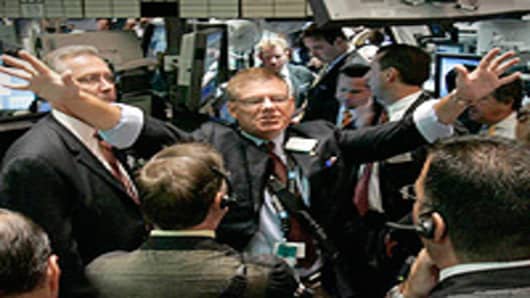Forget the old canard about the market hating uncertainty: It's all the speculation about what the Federal Reserve might do that seems to be driving the fall's unstoppable stock market rally.
Once the central bank finally does make its plans for money injections clear—particularly if it fails to live up to market expectations—that could set the stage for this year's mother of all sell-the-news moments.
A recent CNBC survey found economists and strategists looking for a $500 billion buying program, commonly referred to as quantitative easing, or QE. But that may not be enough to satisfy those in the trading pits moving the market these days.
"That will crush the market," says Dave Rovelli, managing director of US equity trading at Canaccord Adams. "If it's a half a trillion, you'll see a 10 percent correction for sure in the next few weeks. That will (only) be a quarter of a point of GDP."
A strong market belief that the Fed will implement another round of asset purchases has been at the root of a rally that has seen the Standard & Poor's 500gain nearly 4 percent since Sept. 24 and more than 11 percent since Sept. 1.
Sentiment indicators—often contrarian signs—show nearly half the market players are bulls, or holding the belief that stocks will rise in the near term. The American Association of Individual Investors survey is at a 49 percent bullish rate, the second-highest this year; Investors Intelligence, which samples newsletters, is near 46 percent, the highest since mid-May.
The numbers suggest that market buying is getting overheated.
A big event, like next month's Fed meeting at which it is expected to spell out its intent, could spark a sell-the-news reaction. The term refers to investors' desire to buy ahead of major events, such as earnings or key economic reports, then sell once the news hits and take profits incurred during the run-up.
"Probably a half a trillion in QE is priced in," says Dave Lutz, managing director of trading at Stifel Nicolaus in Baltimore. "If the Fed does come out with QE2 we're going to have an up-200 rally (in the Dow industrials) and a down-300 rally pretty fast."
Lutz thinks the Fed actually might be better off not going through with the asset purchases, a move he thinks actually would instill confidence that the economy is strong enough to move ahead without the benefit of government intervention.
"The pain trade is the Fed not doing QE, the dollar breaking far north and that would kill commodities and hurt most other assets temporarily," he says. "That said, if that occurs we're still going to continue to track well in the year-end. The only reason they wouldn't do it is things are getting more and more positive from an economic standpoint."
Most strategists, though, are hesitant to believe the Fed will take that chance.
The Fed not only will enact a $500 billion asset purchasing program in November but also will leave the door open that "more will come if necessary," says David Bianco, head of US equity strategy at Bank of America Merrill Lynch, which has sent investors a series of bullish research notes in the past several days anticipating a strong move higher in stocks thanks in part to Fed help.
The firm also sees stocks trading at discounts to historical earnings multiples, a trend it says the Fed's position is helping by goosing the economy.
"We see a similar scenario back in early '08, but the S&P 500 appeared to be inexpensive solely because prices were falling faster than earnings deteriorate," writes Savita Subramanian, the firm's quantitative strategist. "Today, the market appears inexpensive for the right reasons: stabilizing prices and still increasing earnings expectations—albeit at a slower pace."
The pervasiveness of highly bullish sentiment is making matters difficult for investment pros who see nothing but weak news from the economy. Indeed, money flows are indicating that there's plenty of bearish sentiment.
Even as the market was staging its September rally through what is historically the worst month of the year, corporate insiders were selling $5.4 billion worth of shares, the highest level since March, according to TrimTabs. Insider buying fell to $230 million for the month, the lowest since August 2009.
"If stock prices keep levitating, we expect insider selling to skyrocket in the next few weeks as earnings season blackouts lift," the research firm said in a report.
So while the Dow may hold its 11,000 positionas another decent earnings season progresses, market bulls will be waiting on the other side to see what November's Fed meeting, along with a contentious election, holds for the future.
Stock market investors have been betting on a weak dollaras the result of all the Fed tampering. Should the US currency start to strengthen after the Fed finally does move, all bets would be off.
"If the dollar starts to come up and gold starts to go down, money could easily flow out of the markets. All I can tell you is it's really frustrating," says Kathy Boyle, president of Chapin Hill Advisors in New York. "It could be very swift when it does come. That's the problem."
Follow Jeff Cox on Twitter @JeffCoxCNBCcom



